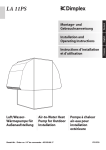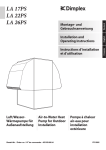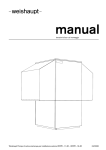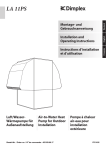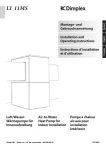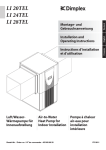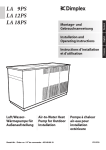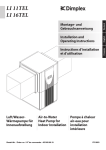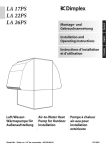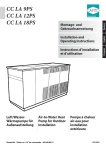Download Dimplex LA 22PS Operating instructions
Transcript
Luft/WasserWärmepumpe für
Außenaufstellung
Installation and
Operating Instructions
English
Instructions d’installation
et d’utilisation
Français
Montage- und
Gebrauchsanweisung
Air-to-Water Heat
Pump for Outdoor
Installation
Bestell-Nr. / Order no. / No de commande : 452159.66.04
Deutsch
LA 17PS
LA 22PS
LA 26PS
Pompe à chaleur
air-eau pour
installation
extérieure
FD 8703
Table of contents
1
Please Read Immediately .............................................................................................................E-2
1.1 Important Information.............................................................................................................................. E-2
1.2 Legal Regulations and Directives ........................................................................................................... E-2
1.3 Energy-Efficient Use of the Heat Pump .................................................................................................. E-2
2
Purpose of the Heat Pump ...........................................................................................................E-3
3
Scope of Delivery ..........................................................................................................................E-3
3.1 Basic Device ........................................................................................................................................... E-3
3.2 Switch Box .............................................................................................................................................. E-4
3.3 Heat Pump Controller ............................................................................................................................. E-4
4
Transport........................................................................................................................................E-4
5
Set-up .............................................................................................................................................E-5
5.1 General Information ................................................................................................................................ E-5
5.2 Condensed Water Pipe........................................................................................................................... E-5
6
Installation .....................................................................................................................................E-5
6.1 General Information ................................................................................................................................ E-5
6.2 Heating System Connection ................................................................................................................... E-5
6.3 Electrical Connection .............................................................................................................................. E-6
7
Start-up...........................................................................................................................................E-6
7.1 General Information ................................................................................................................................ E-6
7.2 Preparation ............................................................................................................................................. E-6
7.3 Procedure ............................................................................................................................................... E-6
8
Maintenance / Cleaning ................................................................................................................E-7
8.1 Maintenance ........................................................................................................................................... E-7
8.2 Cleaning the Heating System ................................................................................................................. E-7
8.3 Cleaning the Air System ......................................................................................................................... E-8
9
Faults / Trouble-Shooting .............................................................................................................E-8
10 Decommissioning/Disposal .........................................................................................................E-8
11 Device Information ........................................................................................................................E-9
Anhang / Appendix / Annexes ............................................................................................................ A-I
www.dimplex.de
E-1
English
2.1 Application .............................................................................................................................................. E-3
2.2 Operating Principle ................................................................................................................................. E-3
1
1
Please Read
Immediately
1.1
Important Information
ATTENTION!
Any work on the heat pump may only be performed by authorised and
qualified after-sales service technicians.
ATTENTION!
English
The device is not suitable for operation with a frequency converter.
ATTENTION!
Never install the device in rooms in which there are any permanent
ignition sources.
ATTENTION!
When transporting the heat pump, ensure that it is not tilted more than
45° (in any direction).
ATTENTION!
The heat pump and transport pallet are only joined by the packing film.
ATTENTION!
Do not restrict or block the area around the air intake or outlet.
ATTENTION!
Ensure that there is a clockwise rotating field: Operating the compressor
in the wrong rotational direction could cause damage to the compressor.
ATTENTION!
Never use cleaning agents containing sand, soda, acid or chloride as
these can damage the surfaces.
ATTENTION!
We recommend the installation of a suitable corrosion protection system
to prevent the formation of deposits (e.g. rust) in the condenser of the
heat pump.
ATTENTION!
The refrigerating circuit may not be damaged in any way.
ATTENTION!
Before opening the device, ensure that all circuits are isolated from the
power supply.
1.2
Legal Regulations and
Directives
The construction and design of the heat pump complies with all
relevant EU directives, DIN/VDE regulations (see CE declaration
of conformity).
The relevant VDE, EN and IEC standards must be adhered to
when connecting the heat pump to the power supply or carrying
out maintenance work. Any further connection requirements stipulated by local utility companies must also be observed.
When connecting the heating system, all applicable regulations
must also be adhered to.
ATTENTION!
Any work on the heat pump may only be performed by authorised and
qualified after-sales service technicians.
Persons, especially children, who are not capable of operating
the device safely due to their physical, sensory or mental abilities
or their inexperience or lack of knowledge, must not operate this
device without supervision or instruction by the person in charge.
Children must be supervised to ensure that they do not play with
the device.
1.3
Energy-Efficient Use of the
Heat Pump
With the purchase of this heat pump you are helping to protect
the environment. A prerequisite for energy-efficient operation is
the correct design of the heat source system and heating system
(radiators and circulation pump).
It is particularly important for the efficiency of a heat pump to
keep the temperature difference between heating water and heat
source as small as possible. For this reason, it is advisable to design the heat source and heating system very carefully. A temperature difference of approx. one Kelvin increases the
power consumption by around 2.5%. When designing the
heating system, it should be borne in mind that special consumers such as e.g. domestic hot water preparation should also be
taken into consideration and dimensioned for low temperatures.
Underfloor heating systems (panel heating) are optimally
suited for heat pump use on account of the low flow temperatures
(30 °C to 40 °C).
It is important to ensure that the heat exchangers are not contaminated during operation because this increases the temperature difference, in turn reducing the COP.
Correct adjustment of the heat pump controller is also important
for energy-efficient use of the heat pump. Further information can
be found in the heat pump controller’s operating instructions.
E-2
3.1
2
Purpose of the Heat
Pump
2.1
Application
The air-to-water heat pump is designed for use in existing or
newly built heating systems.
3
3.1
Scope of Delivery
Basic Device
The heat pump is of compact design and is supplied complete
with the components listed below.
R290 (propane) is used as refrigerant.
It is designed exclusively for heating domestic hot water and
heating water!
English
The heat pump is suitable for mono energy and bivalent operation down to an external temperature of -20 °C.
Proper defrosting of the evaporator is guaranteed by maintaining
a heating water return flow temperature of more than 13 °C during continuous operation.
The heat pump is not designed for the increased heat consumption required when a building is being dried out. The additional
heat consumption should be met using special devices provided
by the customer. If a building is to be dried out in autumn or winter, we recommend installing an additional heating element
(available as an accessory).
ATTENTION!
The device is not suitable for operation with a frequency converter.
2.2
Operating Principle
Surrounding air is drawn in by the ventilator and fed via the evaporator (heat exchanger). The evaporator cools the air, i.e. it extracts heat from it. This extracted heat is then transferred to the
working medium (refrigerant) in the evaporator.
The heat is “pumped” to a higher temperature level by increasing
its pressure with the aid of the electrically driven compressors. It
is then transferred to the heating water using the liquifier (heat
exchanger).
Electrical energy is used to raise the temperature of the heat in
the environment to a higher level. Because the energy extracted
from the air is transferred to the heating water, this type of device
is called an air-to-water heat pump.
The air-to-water heat pump consists of the main components
evaporator, ventilator and expansion valve, as well as the lownoise compressors, liquifier and electrical control system.
1)
Evaporator
2)
Ventilator
3)
Switch box
4)
Compressor
5)
Liquifier
6)
Expansion valve
At low ambient temperatures, humidity accumulates on the evaporator in the form of frost reducing the transfer of heat. The evaporator is defrosted automatically by the heat pump as required.
Steam may be emitted from the air outlet depending on the atmospheric conditions.
www.dimplex.de
E-3
3.2
3.2
Switch Box
The switch box is located in the heat pump. All electrical components are accessible after the front cover and the switch box
cover have been removed.
The switch box contains the supply connection terminals, the
plug connector for the control line, as well as the power contactors and the soft starter unit.
3.3
Heat Pump Controller
English
Use the heat pump controller included in the scope of supply to
operate the air-to-water heat pump.
The heat pump controller is a convenient electronic regulation
and control device. It controls and monitors the entire heating
system on the basis of the external temperature, including domestic hot water preparation and safety systems.
4
Transport
ATTENTION!
Never install the device in rooms in which there are any permanent
ignition sources.
ATTENTION!
When transporting the heat pump, ensure that it is not tilted more than
45° (in any direction).
Use a wooden pallet for transporting the heat pump to the final installation location. The basic device can be transported with a lift
truck, hand truck or by means of 3/4" pipes fed through the holes
in the base plate or frame.
The customer must install the return temperature sensor and the
external temperature sensor, which are supplied with the heat
pump controller / with these instructions together with the necessary fixing accessories.
The enclosed operating instructions describe the function and
use of the heat pump controller.
ATTENTION!
The heat pump and transport pallet are only joined by the packing film.
Before using the transport holes in the frame, it is necessary to
remove the lower side panel assemblies. This is done by loosening each of the two screws at the base and then withdrawing the
panels by unhooking them from above. Rehang the panels by
gently pushing them in an upwards direction.
Be careful not to damage any components when inserting the
pipes through the frame.
Opening the cover
E-4
Closing the cover
6.2
Set-up
5.1
6
General Information
6.1
The heat pump is suited for outdoor installation. The device
should always be installed on a permanently smooth, even and
horizontal surface and must be aligned vertically. The entire
frame should lie directly on the ground to ensure a good soundproof seal and to prevent the water-bearing components from becoming too cold. If this is not the case, additional insulation
measures may be necessary. It must be possible to carry out
maintenance work without hindrance. This can be ensured by
maintaining a clearance of 1.2 m to any fixed walls.
Installation
General Information
The following connections need to be established on the heat
pump:
Flow and return flow of the heating system
Condensate outflow
Control line to the heat pump controller
Power supply
6.2
Heating System Connection
The heating system connections on the heat pump have a 1 1/4"
external thread.
P
P
Route the connection hoses out of the device in a downwards direction. Use a spanner to firmly grip the transitions when connecting the heat pump. After the heat pump has been installed,
the ductwork must be sealed so that the connection is gastight.
P
P
ATTENTION!
Do not restrict or block the area around the air intake or outlet.
5.2
Condensed Water Pipe
Before connecting the heating water system to the heat pump,
the heating system must be flushed to remove any impurities,
residue from sealants, etc., and to prevent any accumulation of
deposits in the liquifier. A contaminated liquifier may cause the
heat pump to completely break down. For systems in which the
heating water flow can be shut off via the radiator or thermostat
valves, an overflow valve must be installed in a heating bypass
downstream from the heat pump by the customer. This ensures
a minimum heating water flow rate through the heat pump and
helps to avoid faults.
Once the heating system has been installed, it must be filled, deaerated and pressure-tested (in the heat pump the air-relief cock
is located at or in the water pipes at the condenser).
Condensed water that forms during operation must be drained
off frost-free. The heat pump must be mounted on a level plane
to guarantee proper drainage. The condensed water pipe must
have a minimum diameter of 50 mm and should be fed frost-free
into a sewer. Condensate should not be discharged directly into
clearing tanks and cesspits because the aggressive vapours
could destroy the evaporator.
$LUUHOLHIFRFN
&RQGHQVHU
Minimum heating water flow rate
The minimum heating water flow rate through the heat pump
must be assured in all operating states of the heating system.
This can be accomplished, for example, by installing either a
manifold without differential pressure or an overflow valve. The
procedure for adjusting an overflow valve is described in the
Chapter Start-up.
Antifreeze
Manual drainage should be provided for heat pumps which are
exposed to frost. The antifreeze function of the heat pump controller is active whenever the controller and the heat circulating
pump are ready for operation. If the heat pump is taken out of
service or in the event of a power failure, the system has to be
drained, and if required, blown out, at three locations (see illustration). The heating circuit should be operated with a suitable
antifreeze if heat pump systems are implemented in buildings
where a power failure can not be detected (holiday home).
www.dimplex.de
E-5
English
5
6.3
7
Start-up
7.1
General Information
To ensure that start-up is performed correctly, it should only be
carried out by an after-sales service technician authorised by the
manufacturer. This may be a condition for extending the guarantee (see Warranty Service).
7.2
Preparation
The following items need to be checked prior to start-up:
English
The heat pump must be fully connected, as described in
Chapter 6.
6.3
Electrical Connection
All valves that could impair the proper flow of the heating
water in the heating circuit must be open.
The air intake and air outlet paths must be clear.
A standard four-core cable is used for connecting the heat pump
to the power supply.
The ventilator must turn in the direction indicated by the arrow.
The power supply and the control line are normally installed in
the ground (in ductwork with a suitable size and resistance) and
routed from the heat pump to the building. This ductwork must
extend into the heat pump by approx. 22 mm and be installed
with a continuous downward slope in order to comply with Section 42 of the VDE 0100 regulations. Instead of 90° bends, two
45° bends must be used as pipe bends. The control line and the
cable for the power supply are drawn into this ductwork.
The settings of the heat pump controller must be adapted to
the heating system in accordance with the controller’s operating instructions.
The cable (power supply) must be provided by the customer. The
conductor cross section is selected in accordance with the power
consumption of the heat pump (see Appendix Device Information) and the applicable VDE (EN) and VNB regulations.
The power supply line on the heat pump must be fed through the
provided cable feedthrough into the switch box. The line must be
firmly screwed to its feedthrough (vapour sealed pipe union).
An all-pole disconnecting device with a contact gap of at least 3
mm (e.g. utility blocking contactor or power contactor) as well as
a 3-pole circuit breaker with common tripping for all external conductors must be installed in the power supply (tripping current in
compliance with the Device Information). Ensure that the incoming supply has a clockwise rotating field when connecting multiphase devices.
Phase sequence: L1, L2, L3.
ATTENTION!
Ensure that there is a clockwise rotating field: Operating the compressor
in the wrong rotational direction could cause damage to the compressor.
The control voltage is supplied via the heat pump controller.
The heat pump controller has a 230 V AC-50 Hz power supply.
Connect the controller in compliance with its own operating instructions (16 A fuse).
The control line (not included in scope of supply) is connected to
the heat pump controller using the two rectangular plug connectors. Use the plug connector located on the base of the heat
pump adjacent to the cable gland in the base plate. More detailed information can be found in the operating instructions of
the heat pump controller.
For detailed information, see Circuit Diagrams in the Appendix.
E-6
Ensure the condensate outflow functions.
7.3
Procedure
The heat pump is started up via the heat pump controller. Adjustments should be made in compliance with the instructions.
If an overflow valve is fitted to maintain the minimum heating
water flow rate, the valve must be adapted to the requirements of
the heating system. Incorrect adjustment can lead to faulty operation and increased energy consumption. We recommend carrying out the following procedure to correctly adjust the overflow
valve:
Close all of the heating circuits that may also be closed during
operation (depending on the type of heat pump usage) so that
the most unfavourable operating state - with respect to the water
flow rate - is achieved. This normally means the heating circuits
of the rooms on the south and west sides of the building. At least
one heating circuit must remain open (e.g. bathroom).
The overflow valve should be opened far enough to produce the
maximum temperature spread between the heating flow and return flow listed in the following table for the current heat source
temperature. The temperature spread should be measured as
close as possible to the heat pump. The heating element of mono
energy systems should be disconnected.
Heat source
temperature
Max. temperature spread
between heating flow and return
flow
From
To
-20 °C
-15 °C
4K
-14 °C
-10 °C
5K
-9 °C
-5 °C
6K
-4 °C
0 °C
7K
1 °C
5 °C
8K
6 °C
10 °C
9K
11 °C
15 °C
10 K
16 °C
20 °C
11 K
21 °C
25 °C
12 K
26 °C
30 °C
13 K
31 °C
35 °C
14 K
8.2
For external temperatures below 10 °C and heating water temperatures below 16 °C, the buffer tank should be heated up with
the second heat generator to at least 25 °C.
Observe the following procedure to implement a smooth start-up:
1)
Close all of the heating circuits.
2)
Fully open the overflow valve.
3)
Use the controller to select the automatic operating mode.
4)
Wait until the buffer tank has reached a temperature of at
least 25 °C.
5)
Now slowly reopen the heating circuit valves in succession
so that the heating water throughput is constantly raised by
slightly opening the respective heating circuit. The heating
water temperature in the buffer tank must not be allowed to
drop below 20 °C during this process. This ensures that the
heat pump can be defrosted at any time.
6)
Set the minimum volume flow quantity on the overflow valve
and heat circulating pump when all heating circuits are fully
open and a heating water temperature in the buffer tank of
approx. 20 °C is maintained.
7)
New buildings have an increased heat consumption on account of the energy required to dry them out. This increased
heat consumption means that marginally dimensioned heating systems can not always achieve the desired room temperature. In such cases, we recommend keeping a second
heat generator on standby during the first heating period.
The limit temperature on the heat pump controller should
also be turned up to 15 °C.
8
Maintenance / Cleaning
8.1
Maintenance
To protect the paintwork, avoid leaning anything against the device or putting objects on the device. External heat pump parts
can be wiped with a damp cloth and domestic cleaner.
ATTENTION!
Never use cleaning agents containing sand, soda, acid or chloride as
these can damage the surfaces.
To prevent faults due to sediment in the heat exchanger of the
heat pump, ensure that the heat exchanger in the heating system
can not be contaminated. In the event that operating malfunctions due to contamination still occur, the system should be
cleaned as described below. The device may only be cleaned according to the following instructions from the manufacturer.
8.2
Cleaning the Heating System
The ingress of oxygen into the heating water circuit may result in
the formation of oxidation products (rust), particularly if steel
components are used. These products enter the heating system
via the valves, the circulating pumps and/or plastic pipes. It is
therefore essential - in particular with respect to the piping of underfloor heating systems - that only diffusion-proof materials are
used.
ATTENTION!
We recommend the installation of a suitable corrosion protection system
to prevent the formation of deposits (e.g. rust) in the condenser of the
heat pump.
Residue from lubricants and sealants may also contaminate the
heating water.
In the case of severe contamination leading to a reduction in the
performance of the liquifier in the heat pump, the system must be
cleaned by a heating technician.
According to today’s state of knowledge, we recommend using a
5 % phosphoric acid solution for cleaning purposes. However, if
cleaning needs to be performed more frequently, a 5 % formic
acid solution should be used.
In either case, the cleaning fluid should be at room temperature.
We recommend flushing the heat exchanger in the direction opposite to the normal flow direction.
To prevent acidic cleaning agents from entering the heating system circuit, we recommend connecting the flushing device directly to the flow and return flow of the liquifier of the heat pump.
It is important that the system be thoroughly flushed using appropriate neutralising agents to prevent any damage from being
caused by cleaning agent residue remaining in the system.
Acids must be used with great care and all relevant regulations of
the employers’ liability insurance associations must be adhered
to.
If in doubt, contact the manufacturer of the chemicals!
www.dimplex.de
E-7
English
Any faults occurring during operation are also displayed on the
heat pump controller and can be corrected as described in the
operating instructions of the heat pump controller.
8.3
8.3
Cleaning the Air System
Evaporator, ventilator and condensate outflow should be cleaned
of contamination (leaves, twigs, etc.) before each new heating
period.
Do this by opening the front of the heat pump. The bottom should
be opened first followed by the top.
ATTENTION!
Before opening the device, ensure that all circuits are isolated from the
power supply.
English
Remove and rehang the side panel assemblies as described in
Chapter 4.
To prevent the evaporator and the condensate tray from being
damaged, do not use hard or sharp objects for cleaning.
ATTENTION!
The refrigerating circuit may not be damaged in any way.
Inflammable refrigerant could leak out if the refrigerating circuit is
damaged. Ignition sources and open flames must be avoided
when carrying out any work on the device.
Under extreme weather conditions (e.g. snow drifts), ice may
form on the air intake and exhaust air outlet grids. If this happens,
the ice must be removed in the vicinity of the air intake and exhaust air outlet grids to ensure that the minimum air flow rate is
maintained.
E-8
9
Faults / TroubleShooting
This heat pump is a quality product and is designed for troublefree and maintenance-free operation. In the event that a fault
should occur, it will be indicated on the heat pump manager display. Simply consult the Faults and Trouble-shooting page in the
operating instructions of the heat pump manager. If you cannot
correct the fault yourself, please contact your after-sales service
technician.
ATTENTION!
Any work on the heat pump may only be performed by authorised and
qualified after-sales service technicians.
Anyone carrying out work on the refrigerating circuit must be certified to safely handle inflammable refrigerants or be supervised
by a person having such certification.
10 Decommissioning/
Disposal
Before removing the heat pump, disconnect it from the power
source and close all valves. Observe all environmentally-relevant
requirements regarding the recovery, recycling and disposal of
materials and components in accordance with all applicable
standards. Particular attention should be paid to the proper disposal of refrigerants and refrigeration oils.
11
1
Type and order code
2
Design
2.1
Degree of protection according to EN 60 529 for compact devices
and heating components
2.2
Installation Location
3
Performance data
3.1
Operating temperature limits:
Heating water flow/return flow 1
°C / °C
Air
°C
3.2
Temperature spread of heating water at A7 / W35
3.3
Heat output / COP
at A-7 / W35 2
at A-7 / W45
2
at A2 / W35 2
at A7 / W35
at A7 / W45
3.4
kW / ---
2
Sound power level
kW / ---
kW / ---
2
at A10 / W35
kW / ---
kW / ---
2
kW / ---
Sound pressure level at a distance of 10 m (air outlet side) dB(A)
3.6
Heating water flow with an internal pressure differential of m³/h / Pa
3.7
Air flow rate
m³/h
3.8
Refrigerant; total filling weight
type / kg
4
Dimensions, connections and weight
4.1
Device dimensions
H x W x L cm
4.2
Device connections to heating system
Inch
4.3
Weight of the transportable unit(s) incl. packing
kg
5
Electrical connection
5.1
Nominal voltage; fuse protection
Nominal power consumption
LA 22PS
LA 26PS
IP 24
IP 24
IP 24
Outdoors
Outdoors
Outdoors
Up to 65 / above 18
Up to 65 / above 18
Up to 65 / above 18
-20 to +35
-20 to +35
-20 to +35
9.3
5.0
9.5
5.0
9.4
5.0
3
6.7 / 2.5
6.4 / 2.4
7.7 / 2.4
7.5 / 2.3
8.7 / 2.4
8.4 / 2.2
4
11.4 / 2.6
10.8 / 2.5
13.6 / 2.6
13.1 / 2.5
14.4 / 2.6
13.9 / 2.5
3
6.0 / 2.2
7.0 / 2.2
7.8 / 2.3
4
10.3 / 2.2
12.5 / 2.3
13.3 / 2.3
3
8.7 / 3.2
8.3 / 3.0
10.6 / 3.1
10.5 / 3.0
11.7 / 3.1
11.5 / 3.0
4
14.5 / 3.1
14.3 / 3.0
16.7 / 3.1
16.5 / 3.0
18.8 / 3.1
18.6 / 3.0
3
10.1 / 3.6
9.6 / 3.4
12.6 / 3.8
12.0 / 3.6
13.7 / 3.6
13.3 / 3.5
4
17.3 / 3.5
16.6 / 3.4
22.0 / 3.8
21.1 / 3.5
24.0 / 3.7
22.9 / 3.5
3
9.3 / 2.9
11.3 / 3.0
12.5 / 2.9
4
16.1 / 2.9
20.5 / 3.0
21.6 / 3.0
3
11.8 / 4.1
11.4 / 4.1
13.7 / 4.2
13.5 / 4.1
15.0 / 4.1
4
19.6 / 3.8
19.2 / 3.8
23.4 / 4.0
23.2 / 3.9
26.2 / 4.0
dB(A)
3.5
5.2
LA 17PS
2
V/A
A2 W35
kW
5.3
Starting current with soft starter
A
5.4
Nominal current A2 W35 / cos ϕ
A / ---
6
Complies with the European safety regulations
7
Additional model features
7.1
Defrosting
Type of defrosting
Defrosting tray included
7.2
Heating water in device protected against icing 6
7.3
Performance levels
7.4
Controller internal/external
14.7 / 4.0
25.9 / 4.0
64
68
68
37
41
41
1.6 / 2900 3.0 / 10000 2.0 / 4500 3.5 / 13800 2.2 / 3100 3.8 / 8900
5500
8000
8000
R290 / 1.8
R290 / 2.2
R290 / 2.5
157 x 155 x 85
171 x 168 x 100
171 x 168 x 100
G 1 1/4'' external
G 1 1/4'' external
G 1 1/4'' external
330
360
371
400 / 20 T
4.74
400 / 20 T
4.76
5.4
8.6 / 0.8
9.8 / 0.8
23
8.6 / 0.8
400 / 25 T
5.5
6.1
6.2
9.9 / 0.8
11.1 / 0.8
25
30
11.2 / 0.8
5
5
5
Automatic
Automatic
Automatic
Hot gas
Hot gas
Hot gas
Yes (heated)
Yes (heated)
Yes (heated)
Yes
Yes
Yes
2
2
2
External
External
External
1. See operating limits diagram
2. This data indicates the size and capacity of the system. For an analysis of the economic and energy efficiency of the system, other parameters, such as, in particular, the defrosting
capacity, the bivalence point and regulation, should also be taken into consideration. The specified values, e.g. A2 / W55, have the following meaning: 2 °C external air temperature
and 55 °C heating water flow temperature.
3. Operation with 1 compressors
4. Operation with 2 compressors
5. See CE declaration of conformity
6. The heat circulating pump and the heat pump controller must always be ready for operation.
www.dimplex.de
E-9
English
11 Device Information
Anhang / Appendix / Annexes
1
Maßbild / Dimension Drawing / Schéma coté ............................................................................ A-II
1.1 Maßbild / Dimension Drawing / Schéma coté LA 17PS.......................................................................... A-II
1.2 Maßbild / Dimension Drawing / Schéma coté LA 22PS - LA 26PS ....................................................... A-III
2
Diagramme / Diagrams / Diagrammes ....................................................................................... A-IV
2.1 Kennlinien / Characteristic Curves / Courbes caractéristiques LA 17PS...............................................A-IV
2.2 Kennlinien / Characteristic Curves / Courbes caractéristiques LA 22PS................................................A-V
2.3 Kennlinien / Characteristic Curves / Courbes caractéristiques LA 26PS...............................................A-VI
Stromlaufpläne / Circuit Diagrams / Schémas électriques..................................................... A-VII
3.1
3.2
3.3
3.4
4
Steuerung / Control / Commande .........................................................................................................A-VII
Last / Load / Charge ............................................................................................................................A-VIII
Anschlussplan / Circuit Diagram / Schéma électrique ...........................................................................A-IX
Legende / Legend / Légende..................................................................................................................A-X
Hydraulische Prinzipschemen / Hydraulic Plumbing Diagram / Schémas hydrauliques ..... A-XI
4.1 Monoenergetische Anlage / Mono Energy System / Installation monoénergétique ..............................A-XI
4.2 Monoenergetische Anlage und Warmwasserbereitung / Mono Energy System and Domestic Hot Water
Preparation / Installation monoénergétique et production d’eau chaude..............................................A-XII
4.3 Bivalente Anlage / Bivalent System / Installation bivalente .................................................................A-XIII
4.4 Legende / Legend / Légende.............................................................................................................. A-XIV
5
Konformitätserklärung / Declaration of Conformity / Déclaration de conformité ................A-XV
www.dimplex.de
A-I
Anhang · Appendix · Annexes
3
A-II
(FRXOHPHQWGXFRQGHQVDW
¡LQWPP
.RQGHQVDWDEODXI
,QQHQ¡PP
&RQGHQVDWHRXWIORZ
LQVLGH¡PP
$OOHUHDXGHFKDXIIDJH
6RUWLHGHOD3$&
)LOHWDJHH[WpULHXU´
+HL]XQJVYRUODXI
+HDWLQJZDWHUIORZ
$XVJDQJDXVGHU:3 +HDWSXPSRXWOHW
´$XHQJHZLQGH ´H[WHUQDOWKUHDG
+HDWLQJZDWHUUHWXUQIORZ 5HWRXUHDXGHFKDXIIDJH
+HDWSXPSLQOHW
(QWUpHGDQVOD3$&
´H[WHUQDOWKUHDG
)LOHWDJHH[WpULHXU´
+HL]XQJVUFNODXI
(LQJDQJLQGLH:3
´$XHQJHZLQGH
/XIWULFKWXQJ
'LUHFWLRQRIDLUIORZ
6HQVG
pFRXOHPHQWDLU
)XQGDPHQWSODQ)RXQGDWLRQSODQ3ODQGHIRQGDWLRQ
%HUHLFK'XUFKIKUXQJHQ
%HUHLFK'XUFKIKUXQJHQ
$UHDRIRSHQLQJVIRUKHDWLQJ 3DVVDJHVFLUFXLWGHFKDXIIDJH
+HL]NUHLV.RQGHQVDWDEODXI FLUFXLWFRQGHQVDWHGUDLQ
FLUFXLWFRQGHQVDWHGUDLQ
pFRXOHPHQWGXFRQGHQVDW
+HL]NUHLV.RQGHQVDWDEODXI
pFRXOHPHQWGXFRQGHQVDW
(OHNWURNDEHO
HOHFWULFDOFDEOH
FkEOHpOHFWULTXH
6RFOH3$&
%DVHRIKHDWSXPS
6RFNHO:lUPHSXPSH
/LJQHVpOHFWULTXHV
(OHFWULFOLQHV
(OHNWUROHLWXQJHQ
%HGLHQVHLWH
2SHUDWLQJVLGH
&{WpGHFRPPDQGH
/XIWULFKWXQJ
'LUHFWLRQRIDLUIORZ
6HQVG
pFRXOHPHQWDLU
1.1
/XIWULFKWXQJ
'LUHFWLRQRIDLUIORZ
6HQVG
pFRXOHPHQWDLU
Anhang · Appendix · Annexes
/XIWULFKWXQJ
'LUHFWLRQRIDLUIORZ
6HQVG
pFRXOHPHQWDLU
1
1 Maßbild / Dimension Drawing / Schéma coté
Maßbild / Dimension Drawing / Schéma coté LA 17PS
www.dimplex.de
.RQGHQVDWDEODXI
,QQHQ¡PP
&RQGHQVDWHRXWIORZ
LQVLGH¡PP
+HL]XQJVYRUODXI
+HDWLQJZDWHUIORZ
$XVJDQJDXVGHU:3 +HDWSXPSRXWOHW
´$XHQJHZLQGH ´H[WHUQDOWKUHDG
A-III
%HUHLFK'XUFKIKUXQJHQ
$UHDRIRSHQLQJVIRUKHDWLQJ
$UHDRIRSHQLQJVIRUKHDWLQJ 3DVVDJHVFLUFXLWGHFKDXIIDJH
+HL]NUHLV.RQGHQVDWDEODXI FLUFXLWFRQGHQVDWHGUDLQ
pFRXOHPHQWGXFRQGHQVDW
(OHNWURNDEHO
HOHFWULFDOFDEOH
FkEOHpOHFWULTXH
6RFOH3$&
%DVHRIKHDWSXPS
6RFNHO:lUPHSXPSH
/LJQHVpOHFWULTXHV
(OHFWULFOLQHV
(OHNWUROHLWXQJHQ
%HGLHQVHLWH
2SHUDWLQJVLGH
&{WpGHFRPPDQGH
/XIWULFKWXQJ
'LUHFWLRQRIDLUIORZ
6HQVG
pFRXOHPHQWDLU
Anhang · Appendix · Annexes
(FRXOHPHQWGXFRQGHQVDW
¡LQWPP
$OOHUHDXGHFKDXIIDJH
6RUWLHGHOD3$&
)LOHWDJHH[WpULHXU´
+HDWLQJZDWHUUHWXUQIORZ 5HWRXUHDXGHFKDXIIDJH
+HDWSXPSLQOHW
(QWUpHGDQVOD3$&
´H[WHUQDOWKUHDG
)LOHWDJHH[WpULHXU´
+HL]XQJVUFNODXI
(LQJDQJLQGLH:3
´$XHQJHZLQGH
/XIWULFKWXQJ
'LUHFWLRQRIDLUIORZ
6HQVG
pFRXOHPHQWDLU
/XIWULFKWXQJ
'LUHFWLRQRIDLUIORZ
6HQVG
pFRXOHPHQWDLU
1.2
)XQGDPHQWSODQ)RXQGDWLRQSODQ3ODQGHIRQGDWLRQ
/XIWULFKWXQJ
'LUHFWLRQRIDLUIORZ
6HQVG
pFRXOHPHQWDLU
1.2
Maßbild / Dimension Drawing / Schéma coté LA 22PS - LA 26PS
2
2 Diagramme / Diagrams / Diagrammes
2.1
Kennlinien / Characteristic Curves / Courbes caractéristiques LA 17PS
+HL]OHLVWXQJLQ>N:@
+HDWLQJFDSDFLW\LQ>N:@
3XLVVDQFHGHFKDXIIDJHHQ>N:@
:DVVHUDXVWULWWVWHPSHUDWXULQ>&@
:DWHURXWOHWWHPSHUDWXUHLQ>&@
7HPSpUDWXUHGHVRUWLHGHO
HDXHQ>&@
%HGLQJXQJHQÂ&RQGLWLRQVÂ&RQGLWLRQV
+HL]ZDVVHUGXUFKVDW]
+HDWLQJZDWHUIORZUDWH
'pELWG
HDXGHFKDXIIDJH
PK
9HUGLFKWHU%HWULHE
FRPSUHVVRUPRGH
)RQFWLRQQHPHQWjFRPSUHVVHXUV
Anhang · Appendix · Annexes
9HUGLFKWHU%HWULHE
FRPSUHVVRUPRGH
)RQFWLRQQHPHQWjFRPSUHVVHXU
/XIWHLQWULWWVWHPSHUDWXULQ>&@Â$LULQOHWWHPSHUDWXUHLQ>&@Â7HPSpUDWXUHG
HQWUpHG
DLUHQ>&@
/HLVWXQJVDXIQDKPHLQFO3XPSHQOHLVWXQJVDQWHLO
3RZHUFRQVXPSWLRQLQFOSRZHULQSXWWRSXPS
&RQVRPPDWLRQGHSXLVVDQFH\FRPSULVSDUWGHFRQVRPPDWLRQGHODSRPSH
'UXFNYHUOXVWLQ>3D@
3UHVVXUHORVVLQ>3D@
3HUWHGHSUHVVLRQHQ>3D@
9HUIOVVLJHU
&RQGHQVHU
&RQGHQVHXU
/XIWHLQWULWWVWHPSHUDWXULQ>&@
$LULQOHWWHPSHUDWXUHLQ>&@
7HPSpUDWXUHG
HQWUpHG
DLUHQ>&@
/HLVWXQJV]DKOLQFO3XPSHQOHLVWXQJVDQWHLO
&RHIILFLHQWRISHUIRUPDQFHLQFOSRZHULQSXWWRSXPS
&RHIILFLHQWGHSHUIRUPDQFH\FRPSULVSDUWGHFRQVRPPDWLRQGHODSRPSH
9HUGLFKWHU%HWULHE
FRPSUHVVRUPRGH
)RQFWLRQQHPHQWj
FRPSUHVVHXU
/XIWHLQWULWWVWHPSHUDWXULQ>&@
$LULQOHWWHPSHUDWXUHLQ>&@
7HPSpUDWXUHG
HQWUpHG
DLUHQ>&@
A-IV
+HL]ZDVVHUGXUFKIOXVVLQ>PK@
+HDWLQJZDWHUIORZUDWHLQ>PK@
'pELWG
HDXGHFKDXIIDJHHQ>PK@
2.2
2.2
Kennlinien / Characteristic Curves / Courbes caractéristiques LA 22PS
+HL]OHLVWXQJLQ>N:@
+HDWLQJFDSDFLW\LQ>N:@
3XLVVDQFHGHFKDXIIDJHHQ>N:@
:DVVHUDXVWULWWVWHPSHUDWXULQ>&@
:DWHURXWOHWWHPSHUDWXUHLQ>&@
7HPSpUDWXUHGHVRUWLHGHO
HDXHQ>&@
%HGLQJXQJHQÂ&RQGLWLRQVÂ&RQGLWLRQV
+HL]ZDVVHUGXUFKVDW]
+HDWLQJZDWHUIORZUDWH
'pELWG
HDXGHFKDXIIDJH
PK
9HUGLFKWHU%HWULHE
FRPSUHVVRUPRGH
)RQFWLRQQHPHQWjFRPSUHVVHXUV
9HUGLFKWHU%HWULHE
FRPSUHVVRUPRGH
)RQFWLRQQHPHQWjFRPSUHVVHXU
Anhang · Appendix · Annexes
/XIWHLQWULWWVWHPSHUDWXULQ>&@Â$LULQOHWWHPSHUDWXUHLQ>&@Â7HPSpUDWXUHG
HQWUpHG
DLUHQ>&@
/HLVWXQJVDXIQDKPHLQFO3XPSHQOHLVWXQJVDQWHLO
3RZHUFRQVXPSWLRQLQFOSRZHULQSXWWRSXPS
&RQVRPPDWLRQGHSXLVVDQFH\FRPSULVSDUWGHFRQVRPPDWLRQGHODSRPSH
9HUIOVVLJHU
&RQGHQVHU
&RQGHQVHXU
/XIWHLQWULWWVWHPSHUDWXULQ>&@
$LULQOHWWHPSHUDWXUHLQ>&@
7HPSpUDWXUHG
HQWUpHG
DLUHQ>&@
'UXFNYHUOXVWLQ>3D@
3UHVVXUHORVVLQ>3D@
3HUWHGHSUHVVLRQHQ>3D@
/HLVWXQJV]DKOLQFO3XPSHQOHLVWXQJVDQWHLO
&RHIILFLHQWRISHUIRUPDQFHLQFOSRZHULQSXWWRSXPS
&RHIILFLHQWGHSHUIRUPDQFH\FRPSULVSDUWGHFRQVRPPDWLRQGHODSRPSH
9HUGLFKWHU%HWULHE
FRPSUHVVRUPRGH
)RQFWLRQQHPHQWj
FRPSUHVVHXU
/XIWHLQWULWWVWHPSHUDWXULQ>&@
$LULQOHWWHPSHUDWXUHLQ>&@
7HPSpUDWXUHG
HQWUpHG
DLUHQ>&@
www.dimplex.de
+HL]ZDVVHUGXUFKIOXVVLQ>PK@
+HDWLQJZDWHUIORZUDWHLQ>PK@
'pELWG
HDXGHFKDXIIDJHHQ>PK@
A-V
2.3
2.3
Kennlinien / Characteristic Curves / Courbes caractéristiques LA 26PS
+HL]OHLVWXQJLQ>N:@
+HDWLQJFDSDFLW\LQ>N:@
3XLVVDQFHGHFKDXIIDJHHQ>N:@
:DVVHUDXVWULWWVWHPSHUDWXULQ>&@
:DWHURXWOHWWHPSHUDWXUHLQ>&@
7HPSpUDWXUHGHVRUWLHGHO
HDXHQ>&@
%HGLQJXQJHQÂ&RQGLWLRQVÂ&RQGLWLRQV
+HL]ZDVVHUGXUFKVDW]
+HDWLQJZDWHUIORZUDWH
'pELWG
HDXGHFKDXIIDJH
PK
9HUGLFKWHU%HWULHE
FRPSUHVVRUPRGH
)RQFWLRQQHPHQWjFRPSUHVVHXUV
9HUGLFKWHU%HWULHE
FRPSUHVVRUPRGH
)RQFWLRQQHPHQWjFRPSUHVVHXU
Anhang · Appendix · Annexes
/XIWHLQWULWWVWHPSHUDWXULQ>&@Â$LULQOHWWHPSHUDWXUHLQ>&@Â7HPSpUDWXUHG
HQWUpHG
DLUHQ>&@
/HLVWXQJVDXIQDKPHLQFO3XPSHQOHLVWXQJVDQWHLO
3RZHUFRQVXPSWLRQLQFOSRZHULQSXWWRSXPS
&RQVRPPDWLRQGHSXLVVDQFH\FRPSULVSDUWGHFRQVRPPDWLRQGHODSRPSH
'UXFNYHUOXVWLQ>3D@
3UHVVXUHORVVLQ>3D@
3HUWHGHSUHVVLRQHQ>3D@
9HUIOVVLJHU
&RQGHQVHU
&RQGHQVHXU
/XIWHLQWULWWVWHPSHUDWXULQ>&@
$LULQOHWWHPSHUDWXUHLQ>&@
7HPSpUDWXUHG
HQWUpHG
DLUHQ>&@
/HLVWXQJV]DKOLQFO3XPSHQOHLVWXQJVDQWHLO
&RHIILFLHQWRISHUIRUPDQFHLQFOSRZHULQSXWWRSXPS
&RHIILFLHQWGHSHUIRUPDQFH\FRPSULVSDUWGHFRQVRPPDWLRQGHODSRPSH
9HUGLFKWHU%HWULHE
FRPSUHVVRUPRGH
)RQFWLRQQHPHQWj
FRPSUHVVHXU
/XIWHLQWULWWVWHPSHUDWXULQ>&@
$LULQOHWWHPSHUDWXUHLQ>&@
7HPSpUDWXUHG
HQWUpHG
DLUHQ>&@
A-VI
+HL]ZDVVHUGXUFKIOXVVLQ>PK@
+HDWLQJZDWHUIORZUDWHLQ>PK@
'pELWG
HDXGHFKDXIIDJHHQ>PK@
www.dimplex.de
7RXWHVOHVVHFWLRQVPP Anhang · Appendix · Annexes
SRO
SROH
S{OHV
VDQVIRQFWLRQHQFDVGHIRQFWLRQQHPHQW
DYHFUpJXODWHXUGHSRPSHjFKDOHXU
QRIXQFWLRQLQ+3FRQWUROOHUPRGH
NHLQH)XQNWLRQEHL:35%HWULHE
:lUPHSXPSHQUHJOHU
+HDWSXPSFRQWUROOHU
5pJXODWHXUGHSRPSHjFKDOHXU
SRO
SROH
S{OHV
3.1
$OOFURVVVHFWLRQVPP
$OOH4XHUVFKQLWWHPP
6WHXHUOHLWXQJ[PP
&RQWUROOHDG[PP
/LJQHGHFRPPDQGH[PP
3.1
3 Stromlaufpläne / Circuit Diagrams / Schémas
électriques
Steuerung / Control / Commande
A-VII
8PLQ
/LHIHU]XVWDQG<
$VGHOLYHUHGVWDWH<
(WDWjODOLYUDLVRQ<
3.2
3.2
Anhang · Appendix · Annexes
A-VIII
Last / Load / Charge
3.3
3.3
Anschlussplan / Circuit Diagram / Schéma électrique
www.dimplex.de
Anhang · Appendix · Annexes
6WHXHUOHLWXQJÂ&RQWUROOHDGÂ/LJQHGHFRPPDQGH
1HW]Â0DLQVÂ5pVHDX
6WHXHUOHLWXQJÂ&RQWUROOHDGÂ/LJQHGHFRPPDQGH
/DVWÂ/RDGÂ&KDUJH
$QVFKOXVVOHLWXQJÂ&RQQHFWLQJOHDGÂ
/LJQHGHUDFFRUGHPHQW
JHJQ
\HJQ
MDYH
$GHUXQG3LQQXPPHUQ
:LUHDQGSLQQXPEHUV
1XPpURVGHEULQVHWGHEURFKHV
:lUPHSXPSHQUHJOHU1
+HDWSXPSFRQWUROOHU1
5pJXODWHXUGHSRPSHDFKDOHXU1
$GHU[[XQG3LQQXPPHUQ
:LUH[[DQGSLQQXPEHUV
1XPpURVGHEULQV[[HWGHEURFKHV
9RUVLFKW.OHLQVSDQQXQJ
&DXWLRQ([WUDORZYROWDJH
$WWHQWLRQ7HQVLRQIDLEOH
$GHU[[XQG3LQQXPPHUQ
:LUH[[DQGSLQQXPEHUV
1XPpURVGHEULQV[[HWGHEURFKHV
A-IX
3.4
3.4
Legende / Legend / Légende
Anhang · Appendix · Annexes
E1
E2
E4
Ölsumpfheizung Verdichter 1
Ölsumpfheizung Verdichter 2
Düsenringheizung Ventilator
Oil sump heater for compressor 1
Oil sump heater for compressor 2
Nozzle ring heater, ventilator
Chauffage à carter d’huile compresseur 1
Chauffage à carter d’huile compresseur 2
Chauffage à couronne perforée ventilateur
F4
F5
F23
F41
Pressostat Hochdruck Verdichter 1
Pressostat Niederdruck
Wicklungsschutz Ventilator
Pressostat Hochdruck Verdichter 2
High-pressure switch, compressor 1
Low-pressure switch
Winding protection, ventilator
High-pressure switch, compressor 2
Pressostat haute pression, circuit froid 1
Pressostat basse pression
Blindage de l'enroulement ventilateur
Pressostat haute pression, circuit froid 2
K1
K2
K3
K7
Schütz Verdichter 1
Schütz Ventilator
Schütz Verdichter 2
Halbleiterrelais-Abtauung
Contactor for compressor 1
Contactor, ventilator
Contactor for compressor 2
Semiconductor relay, defrosting
Contacteur compresseur 1
Contacteur ventilateur
Contacteur compresseur 2
Dégivrage ralais statique
M1
M2
M3
Verdichter 1
Ventilator
Verdichter 2
Compressor 1
Ventilator
Compressor 2
Compresseur 1
Ventilateur
Compresseur 2
N1
N7
Wärmepumpenregler
Sanftanlaufsteuerung Verdichter 1
Heat pump controller
Soft start control for compressor 1
N8
Sanftanlaufsteuerung Verdichter 2
Soft start control for compressor 2
Régulateur de pompe à chaleur
Commande de démarrage progressif
compresseur 1
Commande de démarrage progressif
compresseur 2
R7
R9
R12
Kodierwiderstand (2k7/0,25W)
Frostschutzfühler
Abtauendefühler
Coding resistor (2k7 / 0.25 W)
Flow sensor
Defrost end sensor
Résistance de codage (2k7/0,25W)
Sonde antigel
Sonde fin de dégivrage
X1
X2
X4
X8/X11
Klemmenleiste: Lasteinspeisung
Klemmenleiste: interne Verdrahtung
Steckverbinder Steuerleitung / Wärmepumpe
Steckverbinder Steuerleitung /
Wärmepumpenregler
Terminal strip: Incoming supply to the load
Terminal strip: Internal wiring
Plug connector, control line/heat pump
Plug connector, control line /
Heat pump controller
Bornier : alimentation de charge
Bornier : câblage interne
Connecteur ligne de commande/pompe à chaleur
Connecteur de la ligne de commande /
régulateur de pompe à chaleur
Y7
Y8
Magnetventil Hauptleitung (no)
Magnetventil Bypass (nc)
Solenoid valve, main line (no)
Solenoid valve, bypass (nc)
Electrovanne ligne principale (no)
Electrovanne dérivation (nc)
A-X
4.1
4 Hydraulische Prinzipschemen / Hydraulic Plumbing
Diagram / Schémas hydrauliques
Monoenergetische Anlage / Mono Energy System / Installation
monoénergétique
Anhang · Appendix · Annexes
4.1
www.dimplex.de
A-XI
4.2
4.2
Anhang · Appendix · Annexes
A-XII
Monoenergetische Anlage und Warmwasserbereitung / Mono Energy
System and Domestic Hot Water Preparation / Installation
monoénergétique et production d’eau chaude
4.3
Bivalente Anlage / Bivalent System / Installation bivalente
Anhang · Appendix · Annexes
4.3
www.dimplex.de
A-XIII
4.4
4.4
Legende / Legend / Légende
Absperrventil
Shutoff valve
Robinet d’arrêt
Überstromventil
Overflow valve
Vanne de trop-plein
Sicherheitsventilkombination
Safety valve combination
Groupe de valves de sécurité
Umwälzpumpe
Circulating pump
Circulateur
Ausdehnungsgefäß
Expansion vessel
Vase d´expansion
Raumtemperaturgesteuertes Ventil
Room temperature-controlled valve
Vanne commandée par température
Absperrventil mit Rückschlagventil
Shutoff valve with check valve
Robinet d’arrêt avec clapet anti-retour
Absperrventil mit Entwässerung
Shutoff valve with drainage
Robinet d’arrêt avec écoulement
Wärmeverbraucher
Heat consumer
Consommateur de chaleur
Vierwegemischer
Four-way mixer
Mélangeur 4 voies
Temperaturfühler
Temperature sensor
Sonde de température
Flexibler Anschlussschlauch
Flexible connection hose
Tuyau de raccord flexible
Wärmepumpe
Heat pump
pompe à chaleur
Pufferspeicher
Buffer tank
Réservoir tampon
Wärmepumpenregler
Heat pump controller
Régulateur de pompe à chaleur
Elektroverteilung
Electrical distribution system
Distributeur courant électrique
Warmwasserspeicher
Hot water cylinder
Ballon d’eau chaude
Heizkessel
Boiler
Chaudière
E8
Zusatzheizung
Supplementary heating
Chauffage d’appoint
M13
Heizungsumwälzpumpe
Heat circulating pump
Circulateur de chauffage
M18
Warmwasserumwälzpumpe
Hot water circulating pump
Circulateur d’eau chaude
N1
Wärmepumpenregler
Heat pump controller
Régulateur de pompe à chaleur
R1
Außenwandfühler
External wall sensor
Sonde de paroi extérieure
R2
Rücklauffühler
Return flow sensor
Sonde de retour
R3
Warmwasserfühler
Hot water sensor
Sonde d’eau chaude
EV
Elektroverteilung
Electrical distribution system
Distributeur courant électrique
KW
Kaltwasser
Cold water
eau froide
MA
Mischer AUF
Mixer OPEN
Mélangeur OUVERT
MZ
Mischer ZU
Mixer CLOSED
Mélangeur FERME
WW
Warmwasser
Domestic hot water
Eau chaude
0
Anhang · Appendix · Annexes
A-XIV
5
Anhang · Appendix · Annexes
5 Konformitätserklärung / Declaration of Conformity /
Déclaration de conformité
www.dimplex.de
A-XV
Glen Dimplex Deutschland GmbH
Geschäftsbereich Dimplex
Am Goldenen Feld 18
D-95326 Kulmbach
Irrtümer und Änderungen vorbehalten.
Subject to alterations and errors.
Sous réserve d’erreurs et modifications.
+49 (0) 9221 709 565
www.dimplex.de


























